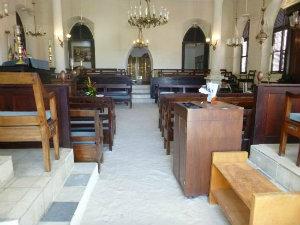Summary | Excerpt | Reading Guide | Reviews | Beyond the Book | Read-Alikes | Genres & Themes | Author Bio

Critics' Opinion:
Readers' Opinion:
First Published:
Aug 2015, 384 pages
Paperback:
Jun 2016, 384 pages
 Book Reviewed by:
Book Reviewed by:
Kim Kovacs
Buy This Book
This article relates to The Marriage of Opposites
Much of The Marriage of Opposites is set in the town of Charlotte Amalie, St. Thomas in the Virgin Islands, and concerns the main characters' Jewish heritage and traditions.
The Virgin Islands were "discovered" by Christopher Columbus on his second voyage in 1493. Many European explorers visited the islands in the ensuing decades and as a result the area was claimed by several nations during the 15th and 16th centuries. St. Thomas was settled by the Danish West India Company in 1672, placing the island under control of the Dutch government and encouraging the first European settlement.
A small number of Jewish settlers arrived on the island of St. Thomas in 1655 as Europeans began colonizing the Virgin Islands. Many of these new residents were Dutch descendants of Jews who had fled the Inquisition's influence in Spain and Portugal. Generally well-educated, these enterprising merchants predominantly made their living in the new environment by trading sugarcane, rum and molasses with Denmark and France.
Although both Judaism and Catholicism were tolerated by the Danish government, both religions were technically illegal until 1685, when King Christian V of Denmark granted adherents permission to worship openly. The Jewish community was initially very small, however, and most services took place in the practitioners' homes.
The Jewish population increased dramatically in 1781, primarily due to an influx of people from the nearby island of St. Eustatius, which had been attacked by the British as a major supplier to the North American colonies with whom they were at war. The population growth justified the founding of a synagogue on St. Thomas in 1796, which was named the Beracha Veshalom Vegemiluth Hasidim ("The Congregation of Blessing and Peace and Loving Deeds"). Although its membership consisted of only nine families when it opened its doors, by 1803 that number had increased to 22.
 The building was rebuilt in the same location three times in its early history: In 1804, when it burned down; in 1823 when it was enlarged to accommodate the congregation which had grown to 64 families; and in 1833 after the synagogue was destroyed by a city-wide fire. It's considered the second-oldest synagogue in the western hemisphere after the Mikve Israel Emanuel Synagogue in Curacao, established in 1651. Since reopening its doors in 1833, Sabbath services have been held every week with the exception of September 15, 1995, when the island was devastated by Hurricane Marilyn.
The building was rebuilt in the same location three times in its early history: In 1804, when it burned down; in 1823 when it was enlarged to accommodate the congregation which had grown to 64 families; and in 1833 after the synagogue was destroyed by a city-wide fire. It's considered the second-oldest synagogue in the western hemisphere after the Mikve Israel Emanuel Synagogue in Curacao, established in 1651. Since reopening its doors in 1833, Sabbath services have been held every week with the exception of September 15, 1995, when the island was devastated by Hurricane Marilyn.
The synagogue has changed little in the years since its founding; its website states that all structures are original and date back to at least 1833. The benches, Ark and bima (pulpit) are fashioned from the mahogany that used to be found on the island, and the menorah is said to date back to 11th century Spain. The synagogue was constructed using rock from a local quarry, and supplemented with bricks that were recycled ballast from the trading ships that docked at St. Thomas. Used as a "placeholder" to balance cargo weight, the bricks were unloaded as goods were brought on to the ships. The mortar that holds it all together was made from sand, limestone and molasses (and is said to taste sweet if you lick it!).
The roof is supported by four pillars that represent the four matriarchs in Judaism: Sarah, Rachel, Rebecca and Leah. One of the synagogue's most unusual features, though, is that throughout its history it's had a sand floor. Some say it symbolizes the desert through which Moses led the Children of Israel, while others maintain that the tradition dates back to the Spanish Inquisition, when sand was spread on the floors of secret meeting rooms to muffle sound. The synagogue was listed in the National Register of Historic Places on August 15, 1997.
At its peak in 1850, it's believed the Jewish community in St. Thomas numbered about 400 individuals. The population declined to about 50 members after the opening of the Panama Canal in 1914, but rebounded to 19th century levels following World War II. A recent influx of Jews from North America has boosted the population to approximately 600 full-time residents and 2,000 who winter there. The synagogue has become a popular tourist attraction, with a small museum and gift shop that attracts an estimated 10,000 visitors each year.
Picture of St. Thomas Synagogue sand floor from Trip Advisor
Filed under Places, Cultures & Identities
![]() This "beyond the book article" relates to The Marriage of Opposites. It originally ran in August 2015 and has been updated for the
June 2016 paperback edition.
Go to magazine.
This "beyond the book article" relates to The Marriage of Opposites. It originally ran in August 2015 and has been updated for the
June 2016 paperback edition.
Go to magazine.





The Funeral Cryer by Wenyan Lu
Debut novelist Wenyan Lu brings us this witty yet profound story about one woman's midlife reawakening in contemporary rural China.
Your guide toexceptional books
BookBrowse seeks out and recommends the best in contemporary fiction and nonfiction—books that not only engage and entertain but also deepen our understanding of ourselves and the world around us.